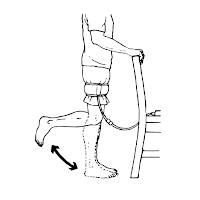For what? Recovery

 KAATSU 3-point Exercises are a fundamental part of the standard KAATSU protocol for the legs.
KAATSU 3-point Exercises are a fundamental part of the standard KAATSU protocol for the legs. The KAATSU 3-point Exercises were invented in the 1970s by Dr Sato. These simple exercises have been performed safely and effectively among millions of individual KAATSU sessions among people of all ages and abilities with myriad physical conditions or ailments.
The KAATSU 3-point Exercises can be performed while you are either doing KAATSU Cycles (tethered or connected to the KAATSU Cycle 2.0) or KAATSU Training (untethered or disconnected to the KAATSU Cycle 2.0).
The KAATSU 3-point Exercises for the legs are either defined as Standard or Advanced.
The Advanced KAATSU 3-point Exercises for the legs are performed by more fit or active individuals or for those individuals with more experience in KAATSU. The 3 Advanced Exercises includes Heel Raises, Standing Leg Curls, and Non-lock Quarter Squats.
The Heel Raises can be done while sitting or standing. The Standing Leg Curls can be performed while standing and holding onto a chair or balancing against a wall. The Non-lock Quarter Squats (or "chair touches") can be performed while bending the knees to touch a chair and then popping back up.
Ideally, the squats are "non-lock" (partial extension) so that your muscles are constantly engaged without rest while your knees are not locked straight (i.e., in a full extension). This will build up fatigue more quickly.
Especially for Baby Boomers and adults who are being reconditioned back to a state of wellness through a simple exercise program, the KAATSU 3-point Exercises can consist of their entire KAATSU training program.
Each set of exercises should be done 3-4 times each with a maximum of 20 seconds rest between each set. Ideally, the number of repetitions for each exercise decreases before you reach muscular or technical failure* (or fatigue).
That is, an ideal set would be 25-30 repetitions on set #1, 10-15 repetitions on set #2, and 5-10 repetitions on set #3. Even if only 1-2 repetitions are completed on the last set, this failure signal sent to the central nervous system is one of the desired outcomes of KAATSU.
* Technical failure is defined when you start to do improper technique (movement) due to an increasing sense of fatigue. At this point, the set should be stopped.
Copyright © 2014-2019 by KAATSU Global
No comments:
Post a Comment